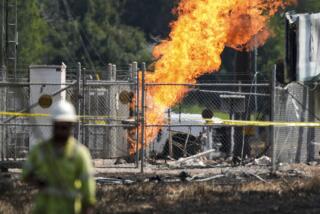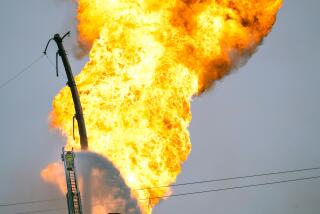San Bruno pipeline explosion: ‘A failure of the entire system’
In a scathing critique, federal investigators blamed Pacific Gas & Electric Co. for what one official called “baffling” mistakes that led to a gas pipeline explosion last September that killed eight people and destroyed 38 homes in the Bay Area last year.
The National Transportation Safety Board also said PG&E exploited the lack of monitoring by regulators, who mistakenly placed “blind trust” in the utility.
The report Tuesday concluded that poor pipeline welds went undetected because of a lack of inspections by the company and inadequate monitoring by state and federal regulators. The utility also lacked a workable emergency response plan that board members said could have helped to prevent the devastation in the city of San Bruno.
“This represents a failure of the entire system — a system of checks and balances that should have prevented this disaster,” said Robert L. Sumwalt, an NTSB board member. “The seam weld may have been the technical reason, but this was an organizational accident.”
Investigators have been revealing details over the last 11 months about what caused the blast, but this marks this first time officials have assigned blame for what went wrong.
Officials said the explosion was triggered by an electrical problem at a control center in Milpitas, about 40 miles from the San Bruno blast site, that caused the valves that regulate pipeline pressure to open, allowing more gas into the line.
As the pressure built up, inadequate welds in a section of pipe ruptured, allowing 47 million cubic feet of gas to escape in a huge pillar of fire. The volume represented enough energy to run 12,000 homes for a year.
The explosion is “the story of flawed pipe, flawed inspection and flawed emergency response,” said Deborah A.P. Hersman, who chairs the NTSB. “It was not a question of if the pipe would fail, but when.”
NTSB officials said PG&E took almost 95 minutes to shut off the gas spewing from the pipeline in San Bruno. The NTSB contends that a lack of automatic shut-off valves and valves that can be closed remotely contributed to the slow response.
But officials said the problems that led to the disaster began with mistakes PG&E made decades earlier.
When the utility relocated the pipeline in 1956, the seams running along the length of the pipe were welded only on the outside, a defect that led to the rupture and a problem that officials said could have been easily discovered with visual inspections.
The company, which operates the pipeline, also mistakenly listed the pipeline section as seamless in its records, when, in fact, it was welded.
“There is scant evidence of quality control measures when the pipeline was installed,” said Donald Kramer, one of the agency’s investigators. “Either the inspections were not done or they were not done properly, and there is no evidence of testing.”
The NTSB asserted that the poor welding would not have have met industry standards at the time, leading the board to conclude that PG&E ignored or overlooked the defect.
The utility missed opportunities to address shortcomings in its pipeline systems after similar systematic problems surfaced during two earlier ruptures, NTSB officials said, one in San Francisco in 1981 and another in Rancho Cordova in 2008.
“How did they get to the point where they have all these deficiencies?” Sumwalt asked. “I’m baffled that these conditions could remain in the system for so long.”
The NTSB dismissed an earlier theory that the pipeline might have been damaged in 2008 by the replacement of an old sewer line, a portion of which passed beneath the gas line. A pipe-bursting machine, which can send vibrations through the ground, was used during the project.
Kramer said the contractor isolated the gas line, and the old clay sewer pipe was removed by hand without using the pipe-bursting machine in that area. Workers did not hit the gas pipeline nor did inspectors note any problems, he said.
In a prepared statement, PG&E President Chris Johns praised the investigation as thorough and said the company would take the NTSB’s findings seriously.
Since the accident, Johns said, the utility has completely reviewed and begun the overhaul of its natural gas operations. For the last year, he added, the company has been making major changes to its operations and management that will put the safety of the public, its customers and employees first.
“We are deeply sorry that our pipeline was the cause,” Johns said. “We know that nothing we can say nor any action we can take will ever make up for the losses experienced by the victims of the accident and the San Bruno community.”
The NTSB also took aim at the California Public Utilities Commission and the federal Pipeline and Hazardous Materials Safety Administration for contributing to the tragedy. They said that in 1961 the utilities commission exempted all natural gas pipelines built before 1961 from pressure testing. The federal government did the same for pipelines built before 1970.
“This has resulted in missed opportunities to find the defective pipe, which had no safety margin and would have failed if tested,” said Robert Hall, an NTSB investigator.
The NTSB estimates that about half the natural gas pipelines in the United States or about 150,000 miles of lines were built before 1970. Because of the exemptions, the NTSB said it wasimpossible to determine the safety levels of those lines. According to the agency, PG&E has assessed only about 65 feet of the 47 miles of gas pipeline it operates through San Bruno and the western part of the Bay Area.
Manufacturing and inspection have improved over the years for new pipelines, said Hersman, “but older pipelines have been excluded. Our oldest pipelines are without a safety net.”
Robert Trainor, another NTSB official, noted that before last year’s explosion, federal pipeline regulators had bestowed a superior rating on the Public Utilities Commission although it had failed to uncover long-standing problems at PG&E.
Board members said they were dismayed that the resources for regulatory agencies have been reduced over the years, forcing inspectors to rely increasingly on representations and self-assessments from utilities that they are doing the right thing.
During Tuesday’s hearing, the NTSB issued more than three dozen safety recommendations to federal regulators, California officials, PG&E and the gas industry. They include calls for new safety audits, better gas-line testing procedures, more thorough record-keeping and improved response procedures for large-scale emergencies.
One of the recommendations instructs the California Public Utilities Commission to conduct a comprehensive audit of all aspects of PG&E’s operations. Another calls on California’s governor to evaluate the ability of the PUC to effectively enforce state pipeline safety regulations.
Times staff writer Tony Barboza contributed to this report.
More to Read
Sign up for Essential California
The most important California stories and recommendations in your inbox every morning.
You may occasionally receive promotional content from the Los Angeles Times.











